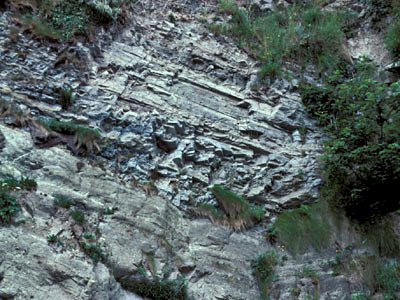Earth Science Conservation Review
| Waterloo - Penarth and Jurassic | Antrim |
| Site Type: | Coastal section |
| Site Status: | ASSI |
| Council area: | Larne Borough Council |
| Grid Reference: | D410034,D409038 |
| Google maps: | 54.85891,-5.80424 |
| Rocks | |
|---|---|
| Rock Age: | Cretaceous, Jurassic, Triassic (Jurassic Undifferentiated, Norian, Rhaetian, Santonian) |
| Rock Name: | Collin Glen Formation, Mercia Mudstone Group, Penarth Group, Port More Formation, Ulster White Limestone Formation, Waterloo Mudstone Formation, Westbury Formation |
| Rock Type: | Basalt, Crinoidal limestone, Dolerite, Limestone, Marl, Mudstone, Shale |
| Interest | |
| Fossil Groups: | Ammonite, Bivalve, Coral, Crinoid, Goniatite |
| Other interest: | fault, Marine sediments |
Summary of site:
This exceptional series of outcrops extends north-west along the shore at Larne from Cheyne Park in the south-east to just beyond Waterloo Cottage; it shows the transition between the Triassic and Jurassic periods. The Triassic rocks, from the oldest and deepest upwards, comprise the reddish-brown lime-rich mudstones of the Port More Formation, topped by greenish-grey but otherwise similar rocks of the Collin Glen Formation, surmounted by the grey shales and mudstones of the final, Rhaetian stage of the Triassic. These Rhaetian rocks then pass indistinguishably into grey mudstones at the base of the Jurassic, to be followed by more grey mudstones with thin limestones. The lower third of the Jurassic period is called the Liassic, often abbreviated to Lias, and all the Jurassic rocks at Larne are part of the Waterloo Mudstone Formation, which is part of the earliest Lower Lias. The exact boundary between the Triassic and Jurassic periods has not been identified here and may be obscured in a fault zone.
The red and grey-green mudstones of the Triassic were deposited in shallow, often temporary lakes in desert lowlands. During the Rhaetian, the sea began progressively to flood into these lowlands and, at Larne, beds crowded with the small marine bivalve shells Rhaetavicula contorta and Eotrapezium betray the onset of marine conditions. About 18m above these beds the earliest Jurassic fossils are found, again marine bivalves. Jurassic rocks can be subdivided into zones, as defined by the ammonites they contain, and the first four zones (planorbis, liasicus, angulata and bucklandi) and possibly the fifth (semicostatum) all occur at Larne.
The Waterloo foreshore and the rocky tide-line and low cliffs behind constitute the largest Jurassic outcrop in Ireland and, because it is constantly refreshed by the erosive effects of the sea, it is one of the best places to collect Jurassic fossils. A rich variety of bivalves, as well as brachiopods, crinoids, gastropods, belemnites and ammonites, can be found and the Ulster Museum has fine slabs bearing the remains of ichthyosaurs and plesiosaurs in its collection.
The red and grey-green mudstones of the Triassic were deposited in shallow, often temporary lakes in desert lowlands. During the Rhaetian, the sea began progressively to flood into these lowlands and, at Larne, beds crowded with the small marine bivalve shells Rhaetavicula contorta and Eotrapezium betray the onset of marine conditions. About 18m above these beds the earliest Jurassic fossils are found, again marine bivalves. Jurassic rocks can be subdivided into zones, as defined by the ammonites they contain, and the first four zones (planorbis, liasicus, angulata and bucklandi) and possibly the fifth (semicostatum) all occur at Larne.
The Waterloo foreshore and the rocky tide-line and low cliffs behind constitute the largest Jurassic outcrop in Ireland and, because it is constantly refreshed by the erosive effects of the sea, it is one of the best places to collect Jurassic fossils. A rich variety of bivalves, as well as brachiopods, crinoids, gastropods, belemnites and ammonites, can be found and the Ulster Museum has fine slabs bearing the remains of ichthyosaurs and plesiosaurs in its collection.
| Enlander, I., Dempster, M. & Doughty, P., 2025. Waterloo - Penarth and Jurassic, County Antrim, site summary. [In] Earth Science Conservation Review. https://www.habitas.org.uk/escr/summary.php?item=16. Accessed on 2025-04-03 |
| Previous Site | Next Site |

